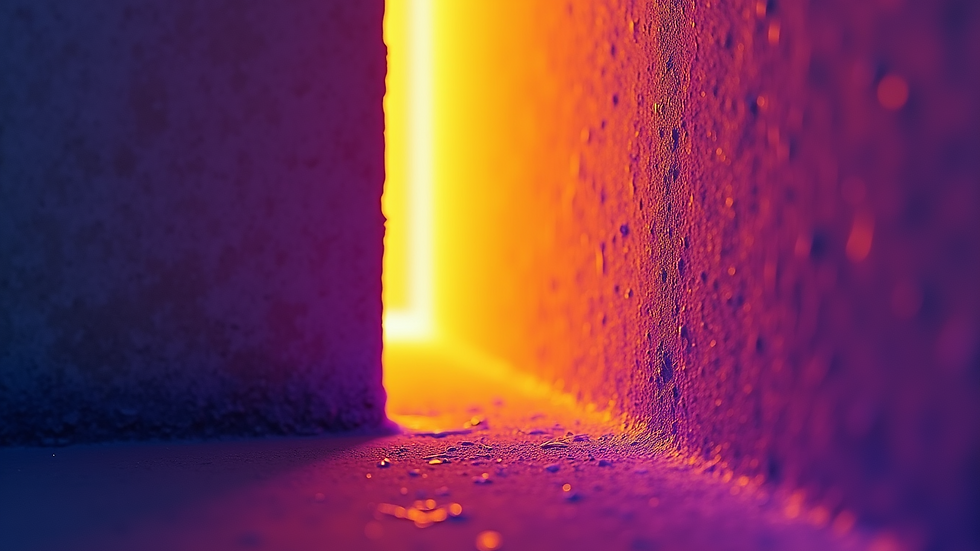Thermal Imaging Inspections: Detecting Hidden Problems
- Elmer Tadpole
- Sep 16
- 4 min read
When you’re about to invest in a home, you want to be sure you’re making a smart choice. But what if some issues are lurking behind walls or under floors, invisible to the naked eye? That’s where infrared home inspections come in! These inspections use advanced technology to reveal hidden problems before they become costly headaches. Let me walk you through how this amazing tool works and why it’s a game-changer for anyone buying a home in Northeastern Oklahoma.
What Are Infrared Home Inspections?
Infrared home inspections use special cameras that detect heat patterns in a building. These cameras capture infrared radiation, which is basically heat energy that all objects emit. By visualizing temperature differences, inspectors can spot things like moisture intrusion, electrical faults, insulation gaps, and even pest infestations.
Imagine walking through a house with a camera that shows you a colorful heat map instead of just walls and floors. Areas that are cooler or warmer than they should be stand out immediately. This makes it easier to identify problems that might otherwise go unnoticed during a traditional inspection.
Why Choose Infrared Inspections?
Non-invasive: No need to tear down walls or ceilings.
Fast and efficient: Inspect large areas quickly.
Accurate detection: Pinpoint exact locations of issues.
Cost-effective: Catch problems early before they escalate.

How Infrared Home Inspections Help You Save Money
One of the biggest benefits of infrared home inspections is the potential to save money. When you buy a home, unexpected repairs can drain your budget fast. But with infrared technology, you get a detailed look at the property’s condition beyond what meets the eye.
For example, moisture hidden behind drywall can cause mold growth, which is expensive to remediate and harmful to health. Infrared cameras can detect cooler, damp areas early on. Similarly, electrical issues like overloaded circuits or faulty wiring show up as hot spots, helping you avoid fire hazards.
Here are some common problems infrared inspections reveal:
Water leaks and moisture intrusion - Detect leaks in roofs, walls, and plumbing.
Insulation gaps - Identify areas where heat escapes, leading to higher energy bills.
Electrical faults - Find overheating wires or panels before they cause damage.
HVAC inefficiencies - Check if heating and cooling systems are working properly.
Pest infestations - Spot nests or colonies hidden inside walls.
By catching these issues early, you can negotiate repairs with the seller or plan your budget accordingly. It’s like having a secret weapon in your homebuying toolkit!

What to Expect During an Infrared Home Inspection
If you decide to get an infrared home inspection, here’s what typically happens:
Pre-inspection walk-through: The inspector will first do a visual check of the property.
Infrared scanning: Using the infrared camera, the inspector scans walls, ceilings, floors, electrical panels, and HVAC systems.
Data analysis: The thermal images are analyzed to identify any anomalies.
Detailed report: You receive a comprehensive report with images and explanations of any issues found.
The whole process usually takes a couple of hours, depending on the size of the home. The best part? You get clear, easy-to-understand information that helps you make confident decisions.
Tips for Preparing for Your Inspection
Make sure the home’s heating or cooling system has been running for at least an hour before the inspection. This helps create temperature differences that the camera can detect.
Avoid scheduling inspections on extremely hot or cold days, as this can affect accuracy.
Be present during the inspection if possible, so you can ask questions and see the images firsthand.

Why Northeastern Oklahoma Homebuyers Should Consider Infrared Inspections
Homes in Northeastern Oklahoma face unique challenges like seasonal temperature swings, humidity, and occasional severe weather. These factors can cause hidden damage that traditional inspections might miss. Infrared home inspections provide an extra layer of protection by revealing issues related to moisture, insulation, and electrical systems that are common in this region.
Plus, with the local real estate market being competitive, having a thorough inspection can give you peace of mind and a stronger negotiating position. You’ll know exactly what you’re getting into and avoid surprises after closing.
If you want to learn more about how thermal imaging inspections can help you, Top-Notch Inspections LLC offers expert services tailored to Northeastern Oklahoma homes. Their team uses state-of-the-art infrared technology to deliver clear, comprehensive reports that empower you to make smart property decisions.
Taking the Next Step Toward a Safer Home
Buying a home is one of the biggest investments you’ll make. Using infrared home inspections is a smart way to protect that investment. It’s like having X-ray vision for your house, revealing hidden problems before they become costly repairs.
If you’re ready to take the next step, consider scheduling an infrared inspection with a trusted local provider. You’ll gain valuable insights, save money in the long run, and enjoy your new home with confidence.
Remember, a little extra effort now can save you a lot of stress later. So why wait? Let infrared technology help you uncover the truth about your future home today!





Comments